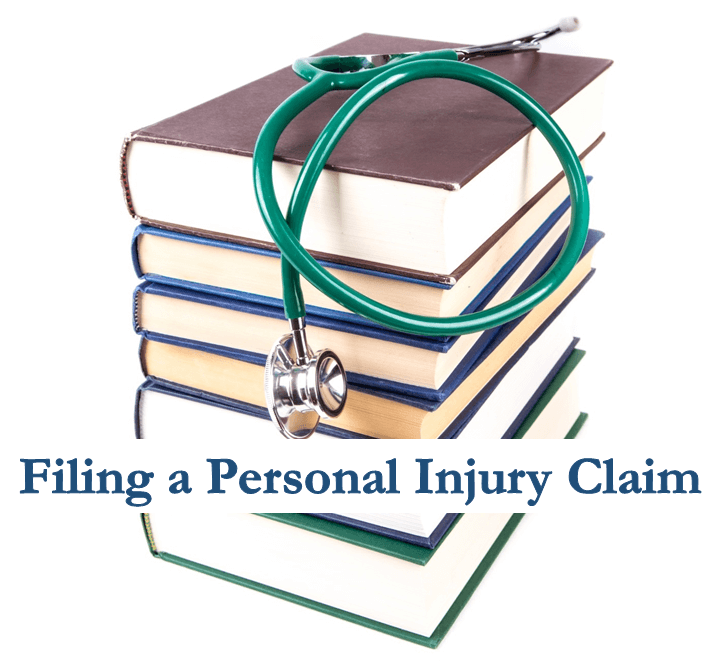Article Update: January 6, 2023
Guide to Filing a Personal Injury Claim
If you want to know how to file a personal injury claim following a car accident, you came to the right article. There are four basic steps to filing a personal injury claim:
1 – Determine if You Have a Viable Claim
2 – Calculate Your Claim Deadlines
3 – Prepare the Claim
4 – File the Claim
We will teach you a summary of these four steps. If you want more details, we offer a free consultation for anyone involved in a vehicle accident. Our lawyers have recovered over $35,000,000 in car and truck accident claims from insurance companies, and we welcome the opportunity to do the same for you.
Keep scrolling for our brief article on how to file an injury claim.
Step 1:
Determine if You Have a Viable Claim
We have an entire page devoted to just this one step, so we will provide a quick summary here. If you want more details on this step, we invite you to read that page.
4 Elements of Negligence
Before you start working through the procedure of filing a claim, you need to determine if you even have a viable claim. What is a viable personal injury claim? One where you have evidence of all 4 elements of negligence:
♦ Duty
♦ Breach of duty
♦ Causation
♦ Damages
This can be as simple as the following example:
Drivers should leave enough space in front of them so they do not rear end cars they are following (Duty). A driver fails to follow that (Breach of Duty), and as a result rear-ends you. That rear-end accident causes you to suffer whiplash (Causation), which results in you having $5,000 in medical expenses and feeling pain in your neck for a month (Damages).
Contributory Negligence
If you are in any of the contributory negligence jurisdictions (Alabama, Maryland, North Carolina, Virginia, Washington, D.C.), you have an extra worry. In those jurisdictions, if you did anything at all that contributed to the accident happening, you do not have a viable claim.
That is because contributory negligence is a 100% bar to recovery. In other words, if you are 1% at fault an the other driver is 99% at fault, in a contributory negligence jurisdiction, you cannot recover even $1 of your damages.
Rules Analysis
Specific rules of the road analysis is required for many accidents to determine which “duties” (i.e., driving rules or statutes) were violated and how strong, or weak, your claim is as a result, or if your claim is even viable.
That is not something that can be summarized into one page – it would require hundreds of pages and articles to outline even a fraction of the many possibilities. You’ll have to call a lawyer for that depth of personal injury insurance claims advice.
Once you’ve figured out if you have a viable personal injury claim, you need to calculate your claim deadline.
Step 2:
Calculate Your Claim Deadline
There are 2 dates, each with some caveats, that you must follow to timely file a personal injury claim.
Government Claim Deadline
If your claim is not against a government entity, you can skip this deadline because it won’t apply to you.
If your claim is against a government entity, you must give the government a very specific type of notice (which varies for each State) of your claim.
Depending on your state, the notice must generally be provided between six to twelve months from the date of the injury related conduct. In California, the government claim notice deadline is six months.
Statute of Limitations
Every claim will have a definitive cutoff by which you must file your claim in court. This is called your “statute of limitations.”
Again, this varies for each state, and also varies for different types of claims. In California, the statute of limitations for personal injury claims for a car accident is two years.
Discovery Rule
The discovery rule allows the statute of limitations to be extended. The rule states that the clock does not start ticking on your statute of limitations until you knew, or reasonably should have known, that you have a claim.
The discovery rule will rarely if ever be relevant for car accident claims. It is more commonly relevant in medical malpractice, contract, and environmental tort claims, where the damages or injury is dormant or invisible for an extended period of time.
Be sure to calendar your claim deadlines. These are your fail-safes to make sure you protect your ability to file a personal injury claim. If you miss one of these claim deadlines, your claim is no-longer viable, even if you have evidence of all four elements of negligence.
Step 3:
Prepare Your Personal Injury Claim
Again, we have a separate page where we outline – with a step-by-step guide – how to prepare and resolve a personal injury claim following a car accident.
To recap what we outlined on that page, here is what you must do to prepare your injury claim (you must do these regardless of whether you want to settle your claim or file a lawsuit for your claim):
1 – Document the Accident
2 – Document the Property Damage
3 – Document Statutes of Limitations
4 – Document Your Injuries
5 – Collect Medical Records
6 – Collect Medical Bills
7 – Collect Lost Wages Evidence
8 – Collect Health Insurance Information
9 – Prepare Settlement Letter
10 – Negotiate Settlement
11 – Pay Off Medical Liens
We expand on each of these 11 steps on that other page. We also have a page on preparing claims for rear-end accidents, though the 11-step guide page is more thorough.
Once you’ve collected all of the necessary evidence (that is possible to collect without filing a lawsuit), and you’ve completed the necessary preparation for everything you’ve collected, you are ready to file your claim.
Step 4: How to File an Injury Claim
Believe it or not, filing a personal injury claim is easier than preparing it.
Settlement
If you are going to settle your claim, then use all of the information you collected to prepare a settlement demand letter. We wrote a very thorough how-to guide on that, and we encourage you to read it if you want to settle your claim.
Litigation
If you are going to file a lawsuit, you simply file a complaint accompanied by the appropriate fee for the state and court in which you are filing your claim. Free templates exist for complaints online, but in my view they are worth what you pay for them. Your complaint must be tweaked for the facts of your case, and jurisdiction analysis should be performed, which will be identified in the complaint.
Negotiation Stalemate
If you’re at a point where settlement talks with an insurance adjuster hit a dead-end, or you’ve caught on to the fact the adjuster is giving you the runaround or trying to shortchange you with one of their many lowball argument techniques, it might be a good time to use your free 30 minute consultation and give us a ring.
Our toll free number is below, as are our email and a contact submission form. When you are ready for help, we are on standby to fight for you. We invite you to read more about our firm, or our team, before reaching out. You can also visit our free online injury settlement value library, or claim handling library.
Get Help
I make it sound easy, but it obviously isn’t. Some of the steps anyone can do, some of the steps anyone can do if they had unlimited time, and other steps are very risky unless you have a good understanding of the law in your jurisdiction and of insurance claim resolution.
If you’ve hit a road block anywhere along the timeline of steps outlined above, you are welcome to call us for help. We live and breath vehicle accidents. Read some of our results and judge for yourself. We take great pleasure in keeping the insurance company honest, which means getting full and fair value for every penny that you lost because of another driver’s negligence.

About the Author
Article Author: This law article was written by attorney Ray Benyamin, Esquire. Mr. Benyamin received his Juris Doctor degree from the Thomas Jefferson School of Law, and his license to practice law from the State Bar of California. His law license number is 277263. He has been practicing law for 10 years. Mr. Benyamin is a registered member of the following legal organizations: Consumer Attorneys Association of Los Angeles (CAALA), the Los Angeles County Bar Association (LACBA), the State Bar of California, the American Bar Association (ABA), and the American Association for Justice (AAJ). Mr. Benyamin has personally helped his clients recover over $10,000,000 in vehicle accident insurance claims in the State of California.
Our Lawyers Serve Clients in Los Angeles, California & Nationally
Serving all of Los Angeles, including Arcadia, Beverly Hills, Claremont, Canoga Park, Chino, Chino Hills, Covina, Diamond Bar, Downey, East Pasadena, El Monte, Encino, Highland Park, Inglewood, La Verne, Long Beach, Malibu, Montebello, Monterey Park, North Hollywood, Northridge, Pasadena, Pomona, Rancho Cucamonga, Reseda, Rosemead, San Gabriel, San Dimas, Santa Monica, Sherman Oaks, South Bay, South LA, South Pasadena, Sunland, Tarzana, Thousand Oaks, Torrance, Van Nuys, Venice, West Covina, West Hollywood, and Westlake Village.
Serving all of California, with a focus on Kern County, Los Angeles County, Orange County, Riverside County, San Bernardino County, San Diego County, Santa Barbara County, and Ventura County.
Serving nationwide in all 50 states on a case-by-case basis with a national network of relationships and on a Pro Hac Vice basis.

